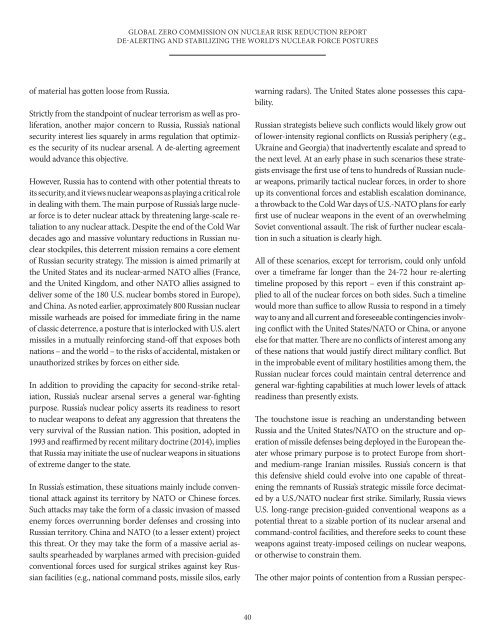global_zero_commission_on_nuclear_risk_reduction_report
global_zero_commission_on_nuclear_risk_reduction_report
global_zero_commission_on_nuclear_risk_reduction_report
You also want an ePaper? Increase the reach of your titles
YUMPU automatically turns print PDFs into web optimized ePapers that Google loves.
GLOBAL ZERO COMMISSION ON NUCLEAR RISK REDUCTION REPORTDE-ALERTING AND STABILIZING THE WORLD’S NUCLEAR FORCE POSTURESof material has gotten loose from Russia.Strictly from the standpoint of <strong>nuclear</strong> terrorism as well as proliferati<strong>on</strong>,another major c<strong>on</strong>cern to Russia, Russia’s nati<strong>on</strong>alsecurity interest lies squarely in arms regulati<strong>on</strong> that optimizesthe security of its <strong>nuclear</strong> arsenal. A de-alerting agreementwould advance this objective.However, Russia has to c<strong>on</strong>tend with other potential threats toits security, and it views <strong>nuclear</strong> weap<strong>on</strong>s as playing a critical rolein dealing with them. The main purpose of Russia’s large <strong>nuclear</strong>force is to deter <strong>nuclear</strong> attack by threatening large-scale retaliati<strong>on</strong>to any <strong>nuclear</strong> attack. Despite the end of the Cold Wardecades ago and massive voluntary reducti<strong>on</strong>s in Russian <strong>nuclear</strong>stockpiles, this deterrent missi<strong>on</strong> remains a core elementof Russian security strategy. The missi<strong>on</strong> is aimed primarily atthe United States and its <strong>nuclear</strong>-armed NATO allies (France,and the United Kingdom, and other NATO allies assigned todeliver some of the 180 U.S. <strong>nuclear</strong> bombs stored in Europe),and China. As noted earlier, approximately 800 Russian <strong>nuclear</strong>missile warheads are poised for immediate firing in the nameof classic deterrence, a posture that is interlocked with U.S. alertmissiles in a mutually reinforcing stand-off that exposes bothnati<strong>on</strong>s – and the world – to the <strong>risk</strong>s of accidental, mistaken orunauthorized strikes by forces <strong>on</strong> either side.In additi<strong>on</strong> to providing the capacity for sec<strong>on</strong>d-strike retaliati<strong>on</strong>,Russia’s <strong>nuclear</strong> arsenal serves a general war-fightingpurpose. Russia’s <strong>nuclear</strong> policy asserts its readiness to resortto <strong>nuclear</strong> weap<strong>on</strong>s to defeat any aggressi<strong>on</strong> that threatens thevery survival of the Russian nati<strong>on</strong>. This positi<strong>on</strong>, adopted in1993 and reaffirmed by recent military doctrine (2014), impliesthat Russia may initiate the use of <strong>nuclear</strong> weap<strong>on</strong>s in situati<strong>on</strong>sof extreme danger to the state.In Russia’s estimati<strong>on</strong>, these situati<strong>on</strong>s mainly include c<strong>on</strong>venti<strong>on</strong>alattack against its territory by NATO or Chinese forces.Such attacks may take the form of a classic invasi<strong>on</strong> of massedenemy forces overrunning border defenses and crossing intoRussian territory. China and NATO (to a lesser extent) projectthis threat. Or they may take the form of a massive aerial assaultsspearheaded by warplanes armed with precisi<strong>on</strong>-guidedc<strong>on</strong>venti<strong>on</strong>al forces used for surgical strikes against key Russianfacilities (e.g., nati<strong>on</strong>al command posts, missile silos, earlywarning radars). The United States al<strong>on</strong>e possesses this capability.Russian strategists believe such c<strong>on</strong>flicts would likely grow outof lower-intensity regi<strong>on</strong>al c<strong>on</strong>flicts <strong>on</strong> Russia’s periphery (e.g.,Ukraine and Georgia) that inadvertently escalate and spread tothe next level. At an early phase in such scenarios these strategistsenvisage the first use of tens to hundreds of Russian <strong>nuclear</strong>weap<strong>on</strong>s, primarily tactical <strong>nuclear</strong> forces, in order to shoreup its c<strong>on</strong>venti<strong>on</strong>al forces and establish escalati<strong>on</strong> dominance,a throwback to the Cold War days of U.S.-NATO plans for earlyfirst use of <strong>nuclear</strong> weap<strong>on</strong>s in the event of an overwhelmingSoviet c<strong>on</strong>venti<strong>on</strong>al assault. The <strong>risk</strong> of further <strong>nuclear</strong> escalati<strong>on</strong>in such a situati<strong>on</strong> is clearly high.All of these scenarios, except for terrorism, could <strong>on</strong>ly unfoldover a timeframe far l<strong>on</strong>ger than the 24-72 hour re-alertingtimeline proposed by this <strong>report</strong> – even if this c<strong>on</strong>straint appliedto all of the <strong>nuclear</strong> forces <strong>on</strong> both sides. Such a timelinewould more than suffice to allow Russia to resp<strong>on</strong>d in a timelyway to any and all current and foreseeable c<strong>on</strong>tingencies involvingc<strong>on</strong>flict with the United States/NATO or China, or any<strong>on</strong>eelse for that matter. There are no c<strong>on</strong>flicts of interest am<strong>on</strong>g anyof these nati<strong>on</strong>s that would justify direct military c<strong>on</strong>flict. Butin the improbable event of military hostilities am<strong>on</strong>g them, theRussian <strong>nuclear</strong> forces could maintain central deterrence andgeneral war-fighting capabilities at much lower levels of attackreadiness than presently exists.The touchst<strong>on</strong>e issue is reaching an understanding betweenRussia and the United States/NATO <strong>on</strong> the structure and operati<strong>on</strong>of missile defenses being deployed in the European theaterwhose primary purpose is to protect Europe from shortandmedium-range Iranian missiles. Russia’s c<strong>on</strong>cern is thatthis defensive shield could evolve into <strong>on</strong>e capable of threateningthe remnants of Russia’s strategic missile force decimatedby a U.S./NATO <strong>nuclear</strong> first strike. Similarly, Russia viewsU.S. l<strong>on</strong>g-range precisi<strong>on</strong>-guided c<strong>on</strong>venti<strong>on</strong>al weap<strong>on</strong>s as apotential threat to a sizable porti<strong>on</strong> of its <strong>nuclear</strong> arsenal andcommand-c<strong>on</strong>trol facilities, and therefore seeks to count theseweap<strong>on</strong>s against treaty-imposed ceilings <strong>on</strong> <strong>nuclear</strong> weap<strong>on</strong>s,or otherwise to c<strong>on</strong>strain them.The other major points of c<strong>on</strong>tenti<strong>on</strong> from a Russian perspec-40


